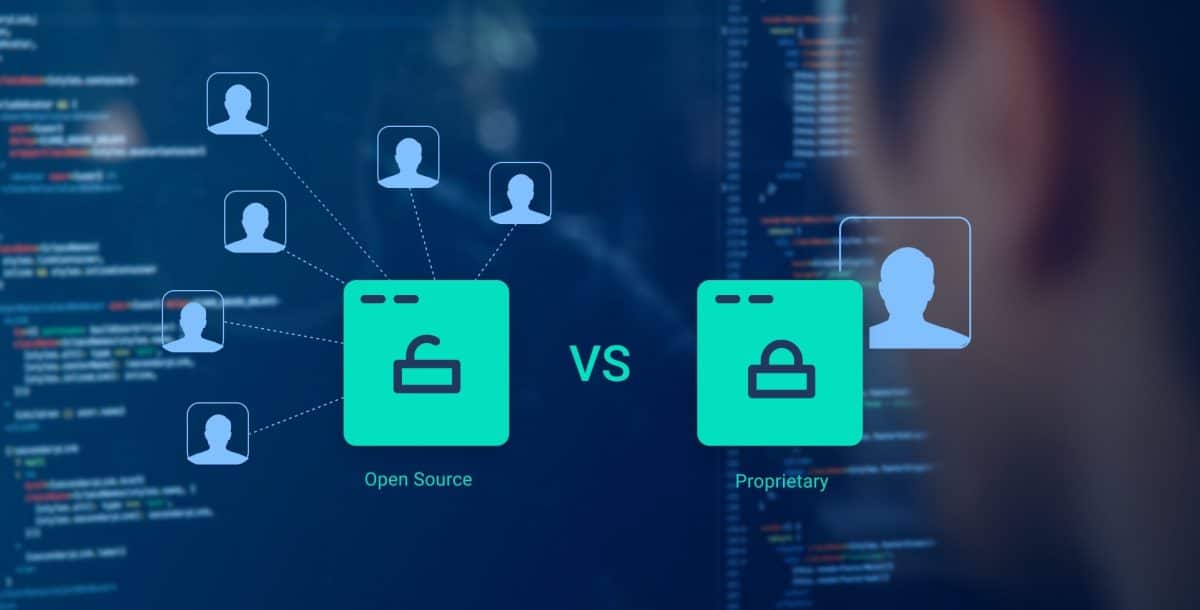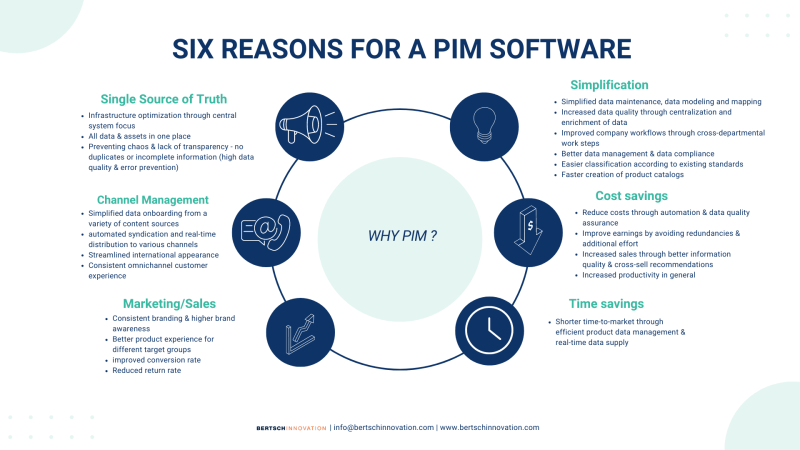Blog
Open Source vs. Proprietary PIM: Key Differences,
Advantages, and Drawbacks

A Product Information Management (PIM) system has become essential for companies with large product portfolios. It streamlines processes, facilitates the management and enrichment of product data, and enables seamless comort. However, once the need for a PIM system is established, the next question arises: Should you choose an open-source PIM or a proprietary PIM?
What are the key differences? What are the advantages and drawbacks of each? And which option best suits your company’s needs? In this article, munication across multiple channels.
By improving efficiency across departments, a PIM system helps businesses maintain high-quality product information while reducing manual eff we’ll provide a clear comparison to help you make an informed decision.
What Is a PIM System?
A Product Information Management (PIM) system is a software solution designed for the centralized management, maintenance, and storage of product data. It allows businesses to efficiently organize product information and distribute it seamlessly across multiple sales channels, including online stores, mobile apps, and print catalogs.
By ensuring data consistency and accuracy, a PIM system helps shorten time-to-market and streamline processes.
Tip: Want to dive deeper? Check out our guide on [What is PIM software]
Reasons for a PIM System
There are numerous reasons for using PIM software. The following graphic illustrates these:
What Does Open Source Mean?
Open source refers to software whose source code is publicly accessible. It is developed, maintained, and continuously improved by a community of developers. Because the code is open, companies can download, implement, modify, and extend it within their own system landscape.
While the core version of open-source software is often free, additional costs may arise for customization, integrations, and professional support services.
Some well-known examples of open-source software include the Linux operating system, the Firefox web browser, and OpenOffice.
What Is Proprietary Software?
Proprietary software is commercially licensed software that requires payment for access. This typically includes an initial license fee along with recurring annual costs for maintenance and support. Unlike open-source software, its source code is not publicly accessible, and modifications are restricted by legal protections.
In exchange, businesses receive a comprehensive package that includes dedicated support, extensive features, regular updates, and enhanced security.
Some well-known examples of proprietary software include Microsoft Office, Adobe Photoshop, and Windows.
Advantages and Disadvantages of Open-Source Software
| Pros of Open Source | Cons of Open Source |
|---|---|
| Free basic version – Reduces initial costs since many open-source solutions have a no-cost core version. | Additional costs for customization & support – Expenses arise for hosting, development, integrations, and professional support. |
| Customizable source code – Businesses can modify the software to fit specific needs. | Requires technical expertise – Implementation and maintenance demand in-house or external development skills. |
| Independence from a single provider – No vendor lock-in, allowing flexibility in system development. | May require extensive customization – Generic open-source solutions may not meet industry-specific needs out of the box. |
| Security and transparency – Public access to the code enables audits, bug fixes, and security reviews. | Potential security risks – If not properly maintained, outdated or poorly configured software can be vulnerable. |
| Large community for support – Many open-source projects have active communities offering guidance. | No guaranteed response times – Community-based support may not be sufficient for urgent business needs. Paid support is often required. |
1. Investment & Cost

Advantage
Open-source software is typically free or low-cost to acquire. Since companies can download and use it without licensing fees, they often save significant upfront costs compared to proprietary solutions.

Disadvantage
However, hidden costs can arise. Expenses for training, customization, hosting, maintenance, and professional support can offset the initial savings, making the total cost of ownership higher than expected.
2. Customizability

Advantage
With open-source software, companies have full access to the source code, allowing them to customize the system to fit their specific business needs. This flexibility is a major advantage for organizations with unique workflows or industry-specific requirements.

Disadvantage
Customization often introduces complexity. Companies need in-house development expertise or external specialists to modify and maintain the software, leading to additional costs and resource allocation.
3. Large Community Support

Advantage
Many open-source projects have active developer communities that continuously improve the software, release updates, and provide solutions to known issues. This collective approach often results in rapid innovation and bug fixes.

Disadvantage
However, open-source projects often have multiple versions or distributions, which may not always be fully compatible with each other. This can create challenges when upgrading, integrating with other systems, or migrating from one version to another.
4. Independence from Vendors & Support Options

Advantage
Open-source solutions provide vendor independence, meaning companies are not locked into a single provider. Businesses can self-manage their PIM system or choose from multiple service providers for hosting, support, and maintenance.

Disadvantage
While community support is available, it does not guarantee fast or personalized assistance. Many companies require service-level agreements (SLAs) to ensure guaranteed response times for troubleshooting and critical issues. Paid support contracts with third-party providers are often necessary but can be costly.
5. Security & Transparency

Advantage
Since the source code is publicly accessible, security experts and developers can audit the software for vulnerabilities and fix issues quickly. In contrast, security flaws in proprietary software are typically addressed only by the vendor, sometimes with delayed patching.

Disadvantage
However, open-source software can also introduce security risks. Because the code is publicly available, malicious actors can analyze it for vulnerabilities. Additionally, security maintenance is the user’s responsibility, requiring dedicated resources or paid support contracts for timely updates and patches.
Advantages and Disadvantages of Proprietary Software
| Pros Proprietary PIM | Cons Proprietary PIM |
|---|---|
| High security standards with regular updates and patches | Higher fixed costs due to licensing and recurring fees |
| Fast, dedicated support, often with guaranteed SLAs | Limited flexibility, as customization depends on the provider |
| User-friendly and intuitive, requiring little technical expertise | Vendor lock-in, creating dependency on the chosen provider |
1. Professional Support & Maintenance

Advantages
Proprietary software providers typically offer dedicated support teams that assist with implementation, technical issues, and regular updates. Support is often included in the licensing agreement, ensuring businesses have direct access to experts who are deeply familiar with the software. Additionally, many providers offer customized solutions and guaranteed service-level agreements (SLAs) for critical issues.

Disadvantages
However, proprietary software creates vendor dependency since the source code is not accessible. This means companies cannot make their own modifications and must rely on the provider for updates and customizations. Additionally, price increases or the discontinuation of support for older versions can be significant drawbacks.
2. User-Friendliness & Customizability

Advantages
Proprietary software is designed with ease of use in mind, often featuring intuitive interfaces and streamlined workflows. Vendors invest heavily in user experience (UX) to make adoption smooth and minimize training efforts. Additionally, proprietary software is often built to integrate seamlessly with existing enterprise systems, making deployment easier.

Disadvanatges
However, customizability is limited. Since the source code cannot be modified, companies must rely on the provider’s feature roadmap and update cycle. If a business has highly specific requirements, it may not be able to implement custom adaptations without vendor approval or additional development costs.
3. Security & Costs

Advantages
With proprietary software, security, updates, and bug fixes are handled directly by the vendor. Businesses benefit from regular security patches, ensuring that vulnerabilities are identified and resolved without requiring internal resources. This reduces the risk of cyber threats and ensures compliance with industry security standards.

Disadvanatges
However, proprietary software comes with higher fixed costs, including license fees, subscription costs, and per-user charges. For large enterprises or companies with multiple users, these expenses can add up quickly, putting pressure on IT budgets. Unlike open-source software, where costs are mainly related to support and customization, proprietary solutions have recurring costs that cannot be avoided.
Which Option Is Right for My Company?
There is no one-size-fits-all answer to this question—it depends on multiple factors, including company size, resources, and specific business needs. Below are some key considerations:

1. Budget
Open Source:
Open-source software is typically free or significantly cheaper than proprietary solutions, making it an attractive option for small businesses and startups with limited financial resources. However, while the initial cost is lower, expenses for technical support, training, and maintenance can add up over time. Additionally, if the desired outcome is more complex than initially anticipated, development and customization efforts may take longer, leading to higher-than-expected costs.
Proprietary:
Proprietary software requires higher upfront and recurring costs for licenses and subscriptions. However, these fees usually include comprehensive support services and regular software updates, ensuring businesses don’t need to worry about additional expenses for major updates, which can be the case with open-source solutions.

2. Time
Open Source:
Open-source solutions often require longer onboarding and training periods, as they tend to be less intuitive and require more technical expertise to configure and use effectively.
Proprietary:
Proprietary software is usually designed with usability in mind, offering a more intuitive interface and faster implementation. This can be an advantage for companies looking for a quick, out-of-the-box solution.

3. Technical Expertise
Open Source:
For businesses with strong technical expertise, open-source software offers flexibility and customization options. Companies that have in-house developers can modify the software to meet specific business needs. However, most organizations lack the necessary internal resources to manage ongoing development and maintenance.
Proprietary:
Proprietary software is typically more stable and reliable because it is fully managed by the provider. This makes it ideal for companies that don’t have the resources or desire to handle technical configurations and prefer a solution that just works.

4. The Long-Term Perspective
When comparing open-source and proprietary software, it’s essential to focus on the long-term benefits and challenges rather than just the short-term cost savings.
While open-source solutions may have lower initial costs, expenses for maintenance, training, and ongoing development can quickly add up—sometimes exceeding the cost of a proprietary solution over time.
Additionally, factors such as compatibility with existing systems and IT security requirements play a crucial role in determining the true long-term investment. Instead of looking solely at upfront expenses, businesses should conduct a comprehensive cost-benefit analysis over the entire software life cycle to make an informed decision.
Conclusion: Which PIM Software Is Right for Me?
The decision between open-source and proprietary software requires careful consideration, and this is especially true for Product Information Management (PIM) systems.
Choosing the right PIM depends on various factors, including a company’s specific needs, internal structure, and available resources.
If your company values flexibility and customization, has strong technical expertise, and does not heavily rely on external support, then an open-source PIM could be a viable option. However, it’s important to factor in the additional effort required for maintenance, updates, and troubleshooting.
On the other hand, if you need a ready-to-use PIM system that integrates seamlessly into your existing software landscape—such as ERP, CRM, or CAD systems—and comes with professional support and regular updates, then investing in a proprietary PIM like mediacockpit is a more strategic choice.
Both options have their advantages and disadvantages, and the decision should not be taken lightly. Since implementing a PIM system is a long-term investment, switching to a different solution later can be costly and complex.
If you want to learn more about how mediacockpit PIM & DAM can support your business, we would be happy to guide you through its benefits.
Highlighted Whitepaper
ePaper: Strategic Product Content Management with PIM & DAM
Comment optimiser la gestion du contenu produit pour un succès à long terme : Découvrez comment rationaliser vos flux de travail avec PIM et DAM. Notre livre blanc offre des informations pratiques et des stratégies éprouvées pour vous aider à mettre en place une approche évolutive, efficace et pérenne de la gestion du contenu produit.
Accomplir plus ensemble
Nous croyons en la valeur de la collaboration et de l’échange. Cela s’applique aussi bien à nos projets clients, desquels nous tirons de nombreuses informations précieuses pour le développement de nos produits, et à notre réseau de partenaires en pleine expansion, avec lequel nous soutenons nos clients dans leur numérisation.




